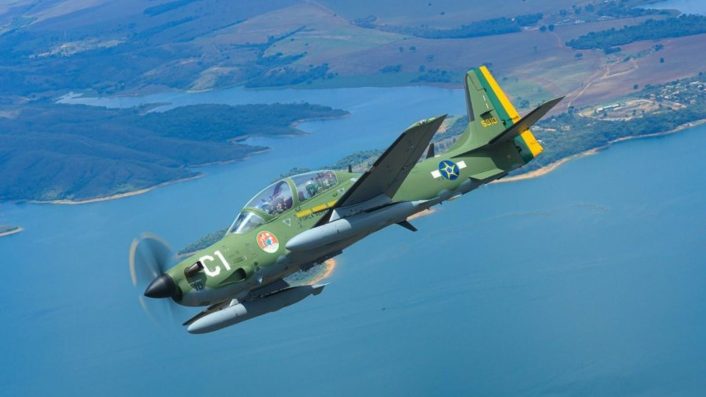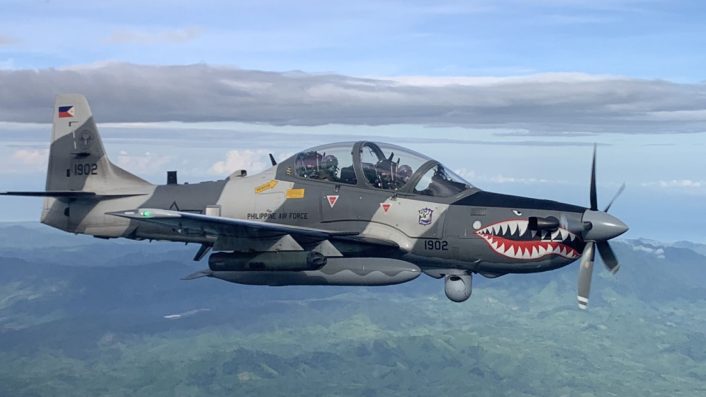The Super Tucano, using laser-guided rockets and guns, would add a cheaper counter-drone capability to counter asymmetric threats.
Brazil’s Embraer has pitched a counter-UAS (Unmanned Aerial System) mission capability for its famous A-29 Super Tucano single-engine turboprop aircraft. Reflecting the current trend of proliferating cheap drones becoming disruptive asymmetric weapons, used by both conventional militaries and non-state actors alike, Embraer said on Nov. 11, 2025, that it is expanding the A-29’s “mission portfolio to counter modern unmanned threats effectively and affordably.”
Both commercial and battlespace developments world over, including the South American continent, are motivating the effort. August saw narcotics smugglers destroy a Colombian National Police UH-60 Black Hawk with an FPV (First Person View) drone. The explosive-strapped UAV hit the aircraft while it was on the ground releasing personnel in an anti-narcotic operation in the forested hilly regions of Amalfi, with twelve personnel reportedly killed in the attack.
In Colombia, local militants used an FPV drone to shoot down a police helicopter UH-60 Black Hawk carrying government personnel in an anti-drug operation. pic.twitter.com/V4vgpCsYAw
— Special Kherson Cat 🐈🇺🇦 (@bayraktar_1love) August 22, 2025
Drug-running operations southwards in Brazil had seen the Brazilian Air Force (Força Aérea Brasileira – FAB) announce a major upgrade of its 68 A-29A/Bs (military designation of the EMB 314) to the A-29M standard with electro-optical sensors, a new cockpit with a WAD (Wide-Angle Display), and a BR-2 datalink to coordinate better with its Saab Gripens.
This would also help Slow Moving Intercept (SMI) roles against small aircraft carrying narcotics. A 2021 incident saw FAB A-29s shooting down an aircraft carrying 265 kg of drugs.
NEWS | Embraer to expand A-29 Super Tucano capabilities to counter Unmanned Aerial Systems. Read full news: https://t.co/OHtfJ5g6Y0 pic.twitter.com/AhVWdMeV0y
— Embraer (@embraer) November 11, 2025
Cost asymmetry and simple drones
The adaptation of the Super Tucano to fight drones is not an isolated development. Another one is the Air Tractor AT-802U Sky Warden, the base aircraft of the OA-1K Skyraider II, which is being adopted by Israel as the Blue Sky Warden.
The goal is to drive down the cost and asymmetry experienced in shooting down Houthi One-Way Attack (OWA) drones. While the goal is similar, that platform is not a close competitor in the Super Tucano‘s class, since it is primarily not a basic fight trainer.

APKWS II rockets, EO systems, heavy armored body, data links, SATCOM antennae and other avionics reflect the dangerously cheap, effective asymmetric threat Israel faced before Houthi drones, and anti-infantry/counter-insurgency operations against Hamas and Hezbollah. However, these are also useful capabilities in a Counter-UAS role.
A U.S. Air Force F-16 Fighting Falcon conducts a combat air patrol over the U.S. Central Command area of responsibility. By delivering critical resources to U.S. and coalition aircraft in flight, we guarantee war-winning airpower throughout the region.@USAFCENT
📷 Staff Sgt.… pic.twitter.com/rwI73H9VXr
— U.S. Central Command (@CENTCOM) October 1, 2025
In Europe, Ukrainian drones have brought down Russian helicopters, while Ukrainian helicopters are shooting down Russian Geran-2 drones by using door guns. An aircraft like the Super Tucano or the AT-802U would allow to spare more costly aerial platforms and surface-to-air defenses while countering drones and cruise missiles.
🔥🔥The crew of the Ukrainian Mi-8 helicopter is chasing and shooting down the russian-iranian heavy kamikaze drone by hitting its tail section with fire from an M134 “Minigun” machine gun pic.twitter.com/410Vr3zrA9
— Angelica Shalagina🇺🇦 (@angelshalagina) November 13, 2025
Israeli Apache helicopters have similarly shot down Hezbollah UAVs, while U.S. Navy MH-60R Seahawk helicopters and French NH90 Caiman naval helicopters have been used to down Houthi drones. Both Russia and Ukraine have also adopted their Soviet-era Yak-52 trainers for the drone-hunting roles.
EUNAVFOR ASPIDES 🇪🇺 | Interception par l’hélicoptère de la frégate 🇫🇷 d’un drone aérien en provenance du Yémen menaçant le trafic maritime civil en mer Rouge.
➡️ La priorité: assurer la liberté de navigation et la sûreté maritime de Suez à Ormuz https://t.co/pJjwPK2c8b pic.twitter.com/KQ8DD17hRL
— Armée française – Opérations militaires (@EtatMajorFR) March 20, 2024
A-29 Super Tucano with APKWS II
There are limitations with using radar-less turboprops with slower speeds and thus longer time to reach the engagement zone. However, if equipped with EO systems, guns and APKWS II rockets, as well as the ability to coordinate with ground radars and bigger aircraft over data links, they could unburden larger aircraft like the F-16s and F-15s and air defense systems from countering pesky drones.
The APKWS II rocket, and especially the AGR-20F FALCO with specific software for counter-drone roles, considerably cuts the cost asymmetry initially experienced before Houthis projectiles. In fact, a single APKWS II 70 mm rocket costs around $30,000, and it is thus more suited for Houthi and Iranian OWA drones worth $15,000-$20,000, compared to AIM-9 Sidewinders and AIM-120 AMRAAMs that cost $450,000 to $1 million apiece.

The existing A-29s have a wing-mounted. 50 mm heavy-caliber machine gun EO/IR (Electro-Optical/Infra-Red) sensor turret, affording a basic counter-drone capability. The press release by Embraer implied integration with the APKWS, or a similar system, that future and current users can opt for.
“Relying on A-29 features in operation and new sensors, including specific datalinks for receiving initial target coordinates and queueing, the Electro-Optical/ Infra-Red (EO/IR) sensor for laser tracking and designation, as well as the laser guided rockets and the wing-mounted .50 machine guns for neutralizing targeted Unmanned Aerial Systems (UAS), the Operational Concept (CONOPS) defined by Embraer will allow current and future A-29 operators to add counter drone missions to their operational profiles whenever needed,” Embraer said.
Evolution in response to current threats
Embraer’s President and CEO Bosco da Costa Junior said the expansion of the A-29 Super Tucano’s capabilities is in response to “the most recent challenges faced by many nations worldwide.”
“The continued challenges in modern warfare and the recent conflicts worldwide have shown the urgent need for solutions to fight drones,” said the President. “The A-29 is the ideal tool to counter UAS effectively and at low cost, adding to the aircraft’s already extensive mission set that includes close air support, armed reconnaissance, advanced training, and many others.”

Like the Skyraider II, the tandem-seat Super Tucano can cover the role of an armed reconnaissance and attack aircraft. These include a rugged, durable design that can be employed from austere airstrips and high loiter time, useful for Close Air Support (CAS), air patrol, air interdiction, Joint Terminal Attack Controller (JTAC) training, armed Intelligence Surveillance and Reconnaissance (ISR), border surveillance, and air escort missions.
The Super Tucano is otherwise a widely used trainer aircraft, operated by 22 air forces which collectively flew 600,000 flight hours. The U.S. Air Force and Portugal are two prominent users, with the former’s Test Pilot School receiving three units early in October 2024.
🚨 FAB e forças de segurança apreendem aeronave e 1 tonelada de cocaína em MT
Nesta sexta-feira (26/09), a Força Aérea Brasileira por meio do Comando de Operações Aeroespaciais (COMAE), em ação conjunta com a Polícia Federal, Gefron/MT, PM/MT e CIOPAER/MT, apreendeu cerca de 1… pic.twitter.com/udI98Uh9p4
— Força Aérea Brasileira 🇧🇷 (@fab_oficial) September 27, 2025
The Super Tucanos were originally acquired by the Air Force Special Operations Command, “but divested after mission requirements changed.” This was after the conclusion of the war in Afghanistan, with the USAF training Afghan pilots to fly the A-29. The 412th Test Wing at Edwards AFB, California, commenced training operations with its A-29Cs this July.









